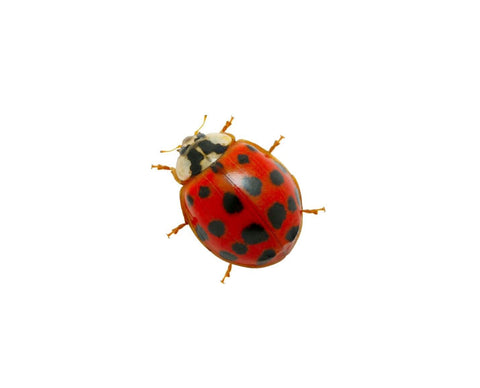Don’t judge a bug by its colors. Asian lady beetles have a striking resemblance to ladybugs. They are even related to the friendly red and black-spotted bugs. While native ladybugs are beneficial to your garden, Asian lady beetles like to invade homes in the fall. We’ve gathered information about Asian lady beetles to help you identify and eliminate an infestation.
What Do Asian Lady Beetles Look Like?

Asian lady beetles are similar in appearance to native ladybugs. However, they come in a variety of colors including red, yellow, and orange. Those with an orange and black body are called Halloween lady beetles. Some Asian lady beetles have noticeable black spots, while others have spots that appear faded. Though most have spots, there are Asian lady beetles that lack them. Asian lady beetles are larger than other lady beetles and can grow to about 1/3ʺ. The easiest way to spot the difference between them and native ladybugs is the M-shaped spot located on their head. An Asian lady beetle’s face also has larger white patches than ladybugs.
Why Asian Lady Beetles Are in Your Home

These bugs have a habit of migrating inside during winter. Unlike native ladybugs, the Asian lady beetle will overwinter in homes. They gather on the sunny parts of buildings and houses. Once temperatures begin to drop, they seek shelter and warmth inside. These bugs are often attracted to homes and buildings with light colors. They are found throughout the United States, but they are most commonly spotted near fields and wooded areas.
Are Asian Lady Beetles Dangerous?

Asian lady beetles gather in large numbers. When these bugs find a suitable place to overwinter, they release pheromones that alert other lady beetles to their location. This can lead to many Asian lady beetles moving into your home. These bugs also secrete a yellow liquid from their legs when crushed or startled. This liquid has an unpleasant scent and can stain walls, fabric, and furniture. Unlike friendly ladybugs, Asian lady beetles are more aggressive. If they feel threatened, they can bite. These bugs can also aggravate allergies and asthma, especially when many are present.
Signs of an Asian Lady Beetle Infestation

Whenever you are dealing with pests, it’s important to identify an infestation as quickly as possible. Check out a few signs that you’re dealing with an Asian lady beetle infestation.
- Beetles on the Exterior of Your Home: These bugs will gather on the sides of buildings and homes before making their way indoors. You will likely spot them outside before you see them in your house.
- Beetles in Your Home: Spotting a few of these bugs in your home doesn’t always mean there’s an infestation. However, it’s important to remember they release pheromones that will attract other lady beetles. One or two lady beetles could quickly lead to a more serious infestation.
- Yellow Stains: Unexplainable yellow stains can also be a sign of these pests. You’re likely to spot these stains on your walls and furniture near entry points like windows and doors.
How to Prevent Asian Lady Beetles

The best way to avoid any infestation is to pest-proof your home. We’ve made a list of tips to help you prevent Asian lady beetles.
- Seal Cracks & Crevices: Asian lady beetles can squeeze into small cracks and crevices. Examine your home for openings that need to be sealed. Check near windows and doors, vents, pipes, and your home’s siding and foundation.
- Check Your Doors & Windows: Make sure your doors and windows are properly sealed. If window and door screens have any tears, you’ll want to repair or replace them.
- Remove Food Sources: Asian lady beetles are known to eat damaged fruit like apples and grapes. Removing fallen fruit will help make your yard less attractive to these bugs.
- Minimize Moisture: Like other pests, Asian lady beetles need access to moisture. Fix any leaky pipes and check for any moisture build-up in your home.
How to Get Rid of Asian Lady Beetles

If these pests have taken over your space, there are things you can do to get them to leave. Check out a few tips to help get rid of Asian lady beetles.
- Spray Them Away: If Asian lady beetles are gathering on the exterior of your home, you’ll want to remove them before they slip inside. You can use soapy water to clean the siding. This should deter them from sticking around.
- Use a Vacuum or Broom: If these bugs are in your home, you can physically remove them with a broom or vacuum. It’s best to avoid crushing them because this can cause them to release an unpleasant odor and can cause staining.
- Treat Your Yard: You can also treat your yard with a plant-based insecticide spray like our Yard Bug Spray. It kills pests and also provides you with residual repellency protection. This will help keep Asian lady beetles from returning to your yard.
- Spot Treat Pests: You can spray these beetles with our Home Bug Spray. It will kill pests, and it also has repellent properties to help keep your home free of these bugs.
While ladybugs are great to have in your garden, you don’t want Asian lady beetles invading your home. One or two of these bugs won’t cause any harm, but large infestations can become a problem, especially when they emerge in the spring. If you’re dealing with a bug problem, we have your back! Check out our Maggie’s Farm Simply Effective™ Pest Control products.
